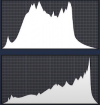This isn't an editing tutorial, it's a camera settings tutorial but I wasn't sure where else to post it.
Drones have small sensors compared to DSLRs. As a result, the light hitting the sensor is less, and therefore the noise levels and image quality at base iso isn't as good as a DSLR. There is however a way to make sure you are getting the best out of the sensor of whatever drone you fly. This technique is common in photography circles but I haven't seen it discussed much in the drone world so I made this video to explain why you should always make the most of the sensor's capabilities.
If you have any questions or require further clarification, let me know in the comments.
Happy flying and have a good weekend.
Drones have small sensors compared to DSLRs. As a result, the light hitting the sensor is less, and therefore the noise levels and image quality at base iso isn't as good as a DSLR. There is however a way to make sure you are getting the best out of the sensor of whatever drone you fly. This technique is common in photography circles but I haven't seen it discussed much in the drone world so I made this video to explain why you should always make the most of the sensor's capabilities.
If you have any questions or require further clarification, let me know in the comments.
Happy flying and have a good weekend.












